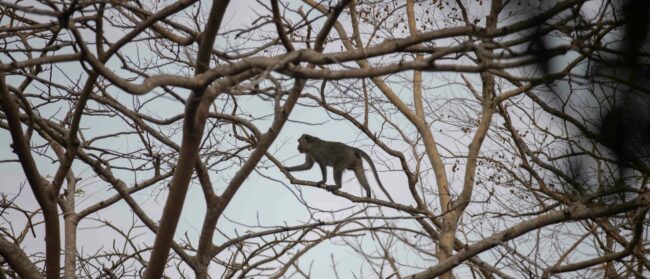Sixty-six-year-old Khieu Saron scurries along a stitched-together path of clay and asphalt just after sunbreak, alerting friends that they should head towards the docks lining Koh Sralao village if they intend to join an excursion to hunt what he calls “long-butt snails” in nearby forests of mangroves.
Less than a fingernail in width and but a few centimetres long, the minute shells cling to the branches of the mangroves, their grayish-brown hue serving as camouflage from the unassuming eye. Roasted, a small bite of snail can be slurped from the head of the cone-like shell. They offer bits of gratification that – in order for those eating them to become full – requires effort echoing the tedious monotony of the snail hunt.
On a good day spent in its entirety beneath the shade of mangrove leaves, climbing over the mud, sand and elevated roots of the natural maze, Saron can collect enough snails to earn a $5 profit – or half that amount with worse luck, he says.
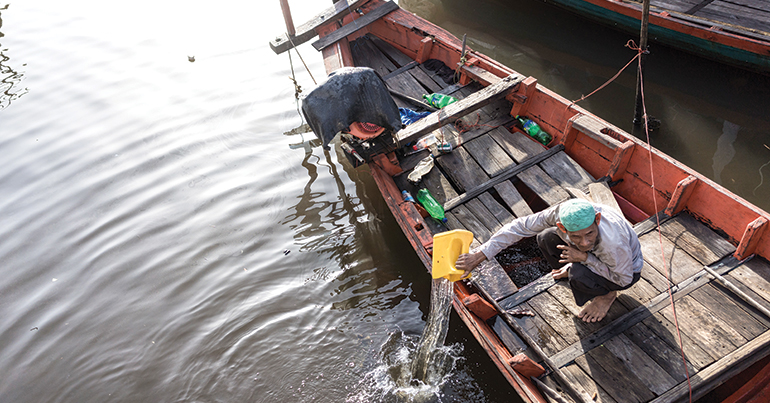
Khieu Saron, 66, prepares his boat to collect shells from the mangrove forest that surrounds Koh Sralao village. Photo: Thomas Cristofoletti
He has survived off of the generosity of the Koh Kong estuary and its mangroves since resettling in the island village of Koh Sralao from Kampot province in 1982, after the fall of the Khmer Rouge regime. His body tells the tale of a man who has laboured tirelessly – his knuckles inflamed as if host to arthritis, his cheeks concave and one eye glazed over with cataracts from a life largely spent floating above the reflection of the sun.
But unlike now, when making ends meet is uncertain and requires great determination and countless snails, Saron once commanded both Koh Sralao and the surrounding waterways with ease.
In 1985, he says, he became village chief under Cambodia’s Vietnamese-backed communist government, spending half of his days fishing and the others in meetings with higher-ranking officials. He was among many to resettle in the quiet community as a fisherman during that time, aware that the island village thrived off of a seemingly endless supply of fish and crab.
“I helped build the community from scratch,” he says – those were the community’s glory days, he explains fervently. “Then, we were happy to catch the fish. The water was waist high, so you would wade through the water and pick the fish up with nets. You could pull two nets from the water and have hundreds of kilograms of fish.”
Less than a decade after Saron relinquished his leadership role in 2000, the village of over 300 families’ record of effortless and bountiful catches came to a halt. “Now, it takes hours just to get one kilogram,” he says.
Bundles of fish nets and stacks of crab cages decorate the decks of the village’s stilted homes, but are now rarely in commission. Now, Saron often hunts snails in lieu of a catch. The change, he says, came after the machines began blaring.
In the late 90s, after a flood of people had resettled in Koh Sralao, the village was part of a collective of islets in Koh Kong province to be dubbed a Ramsar Site, wetlands designated by Unesco to have international importance for their rich ecosystem.
Fish being dried in a house in Koh Sralao. Photo: Thomas Cristofoletti
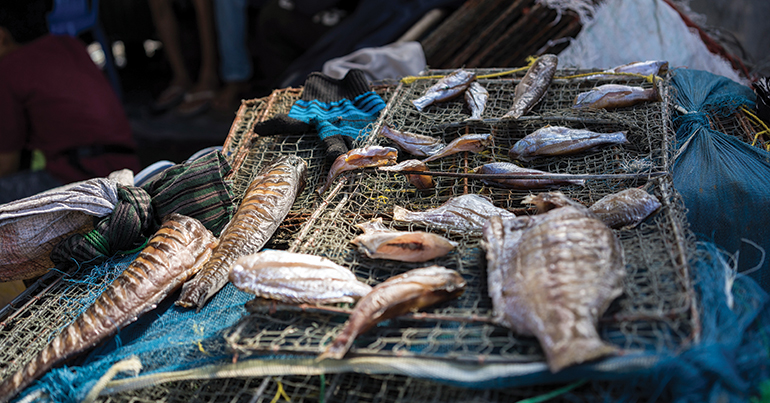
About a decade later, the ecosystem took a dramatic turn. Marine sand dredging kicked off along Cambodia’s coastline, with dredging machines popping up in Sihanoukville, Kampot and Koh Kong.
According to UN records, Cambodia reported exporting 5.9 million tonnes of sand in 2008, compared to less than 20,000 tonnes three years prior. Nearly 16 million tonnes of sand were reported to have been exported from Cambodia between 2007 and 2016, the last available UN records from Cambodia. The majority of this was said to have been sent to Vietnam.
The same database, however, shows records from Singapore of sand imports from Cambodia of nearly five times that amount, or roughly 74 million tonnes – a contradiction that has led some to believe that sand was illegally dredged and trafficked to the city-state. Government officials on either side have instead claimed the discrepancy is due to differing measurement and reporting processes between the two countries, but the Singaporean government has stood by its reported numbers.
Irreversible impact
“The main thing they need it for is land reclamation,” says Vince Beiser, a journalist and author of The World in a Grain: The Story of Sand and How It Transformed Civilization, released last month. “Singapore has been building artificial land with sand for decades and they’re still doing more. They’re constantly building up because they have no space. They’re just this tiny little speck of land, so they use a huge amount [of sand] for that – for building artificial land.”
Beiser says that sand is the third most consumed natural resource in the world after air and water, and it’s quickly running out. The majority of the 50 billion tonnes of sand consumed globally each year goes towards making cement to erect buildings, pave roads and the like. There is yet to be a resource developed or discovered to replace it, he says, and the most realistic solution to the excessive sand consumption is to begin scaling down development and making cities more sustainable.
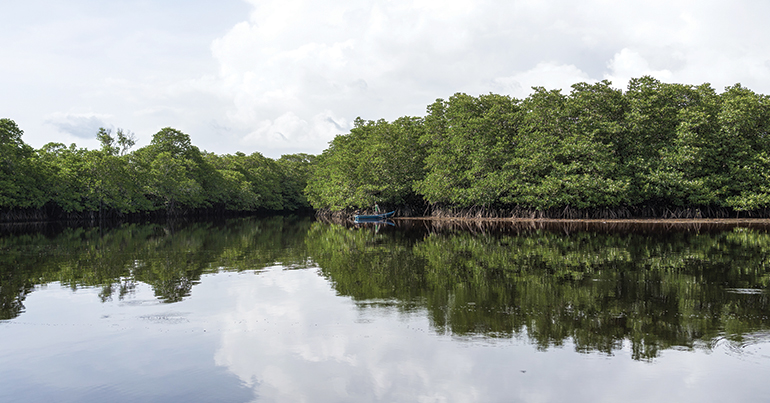
Since gaining independence in 1965, Singapore has expanded dramatically, from 580 square kilometres to 719
Meanwhile, Singapore is scaling up. Since gaining independence in 1965, Singapore has expanded dramatically, from 580 square kilometres to 719, with a national goal of growing to nearly 775 square kilometres by 2030. Sand is to thank for the growth of Southeast Asia’s scintillating island – and a lack of it for ecosystems’ collapse.
“It is the quantity and timing of the flow of both water and sediment that create the very shape of the riverbed, and thus the ecosystems it supports,” World Wildlife Fund’s lead water specialist, Marc Goichet, told Southeast Asia Globe. “It is well known that if you change the quantity or timing of water flow, you will change the river conditions and this will affect nature as well as human users of the water.” The same is true for sand.
“If you mine one site, you create a hole in the bottom of the river,” he says. “Sometimes this will have significantly changed the shape of the entire riverbed and there will be no short-term way of restoring it. The river will have passed a threshold, and whatever you do, including restoring pre-impact sediment delivery, the river shape and associated ecosystems will be changed forever.”
Dams and sand dredging along the Mekong River, for example, caused the annual natural supply of sand to the Mekong Delta to drop by roughly 85 million tonnes from 1990 to 2014, with less than 75 million tonnes now reaching the destination. As a result, “the delta’s coast is losing the equivalent of 1.5 football fields to the sea every day”, Goichet says. Two Vietnamese provinces declared states of emergency as houses collapsed into the river due to the erosion.
Sand dredging damaged not only the river’s livelihood, but also the people’s livelihood. It harms the livelihood, the future, everything
In November 2016, the Cambodian Ministry of Mines and Energy announced that all dredging in Koh Kong had been halted in light of discrepancies between Cambodian and Singaporean trade records. The following July, the government also banned the export of marine and river sand from Koh Kong province overseas. But within that ban, the government made legal the dredging of some estuaries, including Ta Tai and Tropeang Roung, which converge at Koh Sralao, for domestic use. And while Koh Sralao is no longer being dredged, villagers and researchers say the practice carried on after the ban. The Ramsar Site is still suffering as a result.
“Sand dredging damaged not only the river’s livelihood, but also the people’s livelihood,” says Saron. “It harms the livelihood, the future, everything.”
Damage and debt
Man Heat sits on the wood floor of a stilted hut pressed up against two bags of overflowing fishing nets, a krama wrapped around his waist. He looks defeated as he speaks about the current state of the estuary he sits above.
“Normally in an estuary, baby crabs use the waterbed as shelter,” the 52-year-old fisherman of 25 years says. Theirs was once teaming with crabs. “Dredging destroys this, and the water and soil become polluted. They could not survive anymore, so they migrated.”
Fish, too, were deterred by the sound of the dredging and the deeper, murkier water coated in oil let off by the dredging machines, he says. They and their hunters off Koh Srolao were forced to migrate.
“As the sand dredgers came, they dismissed us, moving us from fishing locations where we used to catch a lot of fish. We had to relocate and go farther and farther to sea,” Heat says.
That added to his gasoline costs. But his small and rickety wooden boat is not made for the open sea, making his job more dangerous than it once was, as he is forced to head farther and farther from the docks of Koh Sralao. The amounts of fish and crab that Heat catches have also decreased by at least 50% per catch, he estimates. “It’s been eight years since it started to dramatically decrease,” he says, and the fish and crabs did not return when the dredging stopped.
Still, when the night skies are free of rain and there is no wind on the water to jostle his boat, he and other villagers take to the waterways to cast their nets. These items, left in the water until the early morning when fishermen return to pull them into their boats, are costly, running about $100 each.
Some villagers have had their nets torn by the dredging machines. Many villagers turned to middlemen, who bought their fish to sell at mainland markets, for help replacing the nets, says Furqan Asif, a PhD candidate at the University of Ottawa in Canada whose research focuses on the occupational resilience of the fishing communities of Koh Kong. In exchange for a loan, they would commit to selling their catch only to the middlemen and at a lower rate than the market price in lieu of interest – a smaller income on an already smaller catch.
“That’s how it had been until the MFIs [microfinance institutions], the guys with their nicely dressed attire and their motorbikes, [began] coming in,” says Asif.
Villagers in Koh Sralao say roughly 95% of the community is currently in debt to an MFI.
“Since the sand dredging began, we get very little income and barely survive. We go into debt,” says a 37-year-old fisherman who requested to be referred to as Chin since the topic of sand dredging in Koh Sralao has become taboo. “That’s why people have to go to Thailand or go to the village to find work.”
Defending the waterways
Soth Sophea, 34, goes by the nickname Teav – the equivalent in Cambodian folklore to the maiden in Shakespeare’s Romeo and Juliet. She is Saron’s only daughter and has become known as a rebel in the small community, having defended the estuary against sand dredging as fervently as Juliet would defend her love.
In 2015, she was detained by dredging security guards for four hours with her daughter and brother for allegedly trespassing on a dredging site while guiding tourists as the machines ploughed away. She claims she was never in the wrong since the mangroves the machines were posted on are public property. She has since been watched closely by local officials who she says have tried to silence her.
“They try to limit our freedom to communicate our situation”
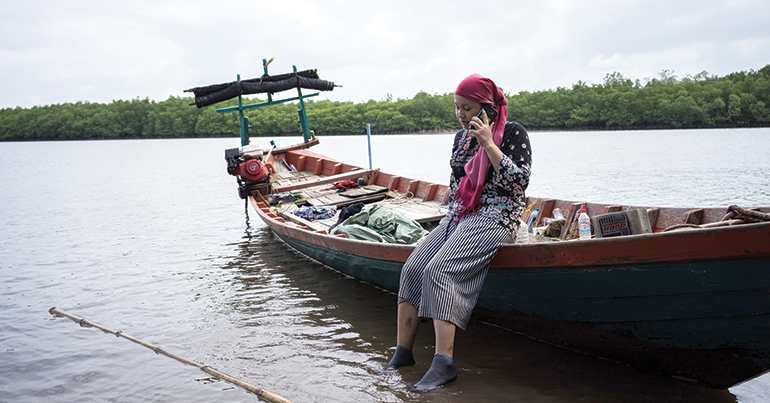
“They try to limit our freedom to communicate our situation,” she says, explaining that her local village chief has attempted to prevent her from speaking to tourists, the media and activists about sand dredging. “It’s censorship.”
Others have not been as lucky as Teav in getting away with standing their ground. Three activists from local NGO Mother Nature Cambodia were accused of threatening to destroy private property, sentenced to 18 months in prison and fined a total of $25,500 in 2016 by the Koh Kong Provincial Court for boarding Direct Access dredging vessels in July 2015. Eight months of their prison term were suspended, but the three activists have taken their case to the Supreme Court to have their names cleared, so far with no success.
In a separate case, two other activists from the local NGO were found guilty by the provincial court in January of “incitement to commit a felony” and recording a person without permission “in a private place” for taking photographs of boats suspected of carrying silica sand off the coast of a special economic zone owned by CPP senator and business tycoon Ly Yong Phat in the months prior. The two were sentenced to a year in prison with seven months suspended and fined $250 each, despite having taken the photos from their own boat on open water more than 1 kilometre from the site.
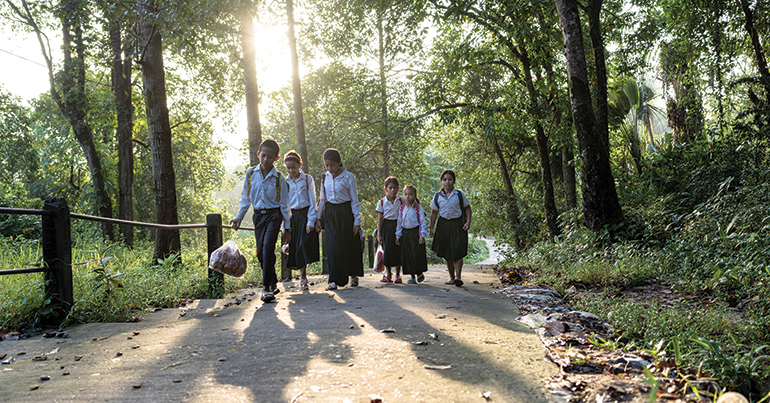
Kids walk to school in Koh Sralao village. Photo: Thomas Cristofoletti
Despite the alleged intimidation, Teav has no plans to remain quiet about the devastation dredging has caused, determined to prevent the activity from returning. She says the Cambodian Centre for Human Rights has provided her with a smartphone and training in how to practice citizen journalism: video documenting dredging or suspicious activity in order to create evidence for her cause in case the community faces similar disruption in the future.
“Those who protest are labelled as opposition, but we’re only trying to stop sand dredging. We don’t represent a political party,” she says.
In fact, Chin, the fisherman, refers to the community as “die-hard fans of the CPP”, rather than its antagonists. It’s the dredging they are against, he says. The CPP’s win in last year’s local elections in Koh Kapi commune, which Koh Sralao falls within, seems to support this claim. But protests may need to be struck up again, Chin fears, since rumours have begun circulating that the dredging will return with Prime Minister Hun Sen’s election.
Saron has heard the same rumour: “We don’t know what’s going on. There are two opinions – one says they will resume sand dredging now that the election is over. Some say no. I’m uncertain. They could resume at any time. I’m worried now… There’s so much equipment still in place, and policemen still guard the place.”
Om Laing, a Koh Kapi commune councillor, says these rumours are false.
“There’s no more sand dredging and there will be no more,” she says.
But she concedes that local authorities have never known in advance about dredging plans: “The dredgers never contacted us. They never asked us, the commune authorities, whether it’s allowed or not. We don’t even know which companies are doing it because they never talked to us about their plan. They just came and did the dredging by themselves without informing the authorities.”
A quick jaunt by boat reveals dredging machines still posted in a nearby waterway, sand piled high on the edge of the water and guards standing watch over the dormant machinery.
While Laing claims authorities had never been approached to get approval by dredging companies, there were 14 authorised to sand-dredge marine soil in Cambodia as of 2015.
“Generally, in any province, the governor has authority over the whole province. But the governor cannot control Ly Yong Phat, so who could?
Chin
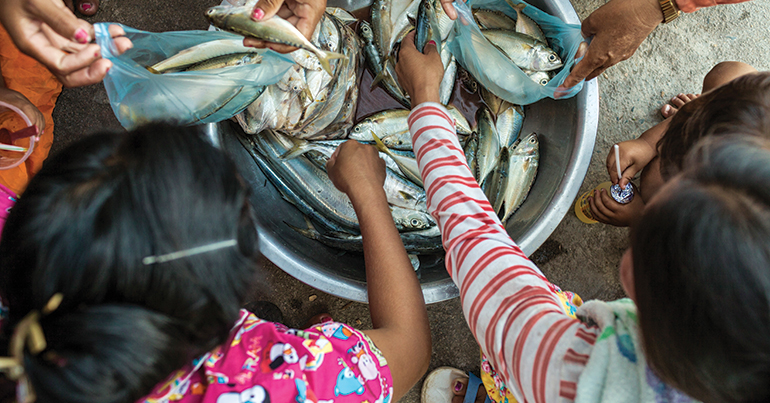
According to Ministry of Mines and Energy records, nearly 2.5 million cubic metres of marine soil were exported by these companies combined between 2007 and 2015. LYP Group Co., owned by Ly Yong Phat, has been significantly busier than the other 13 companies, having exported 1.2 million cubic metres compared to the next runner-up, Udom Seima Peanikch Industry and Mine Co., at roughly half that.
Chin says commune counsellor Laing can’t hold a candle to the tycoon Ly Yong Phat’s authority: “Generally, in any province, the governor has authority over the whole province. But the governor cannot control Ly Yong Phat, so who could? He is the boss of the governor, too.”
If Ly Yong Phat decided to relaunch sand mining in their estuary, Chin says, even Provincial Governor Mithona Phoothang and the laws that protect the waterways would be unable to stop him.
Representatives of LYP Group could not be reached, and the provincial governor declined to speak with Southeast Asia Globe.
Ly Yong Phat, born and raised in Koh Kong, is a household name in the coastal province. In 2000, he was appointed both as a special economic adviser to Prime Minister Hun Sen and as “government delegate” for the development of Koh Kong province, according to his group’s website.
In recent years, his name has been tied to controversial land disputes, including an infamous eight-year-long dispute between 130 families and his company, which was developing the Koh Kong Special Economic Zone, host to some of the garment factories that fishing community members have left to work for. In a separate case, the government announced in March of this year that two land disputes had been resolved between 375 families and the tycoon’s company, which evicted them to build two sugar plantations in Koh Kong province – but the announcement was followed by continued demonstrations in which villagers demanded government action on what they deemed an unresolved issue.
If I were to have stayed in the village, I would be struggling. We can’t catch crab and fish now, and I don’t know if we could do that in the future
Chin says if the senator’s company or other companies choose to dredge Koh Sralao again, as rumours imply, no laws or officials will stop them, and the community will crumble.
Determined survival
It was 2013 when 26-year-old Chao Sreyleak, her three siblings and her husband packed up and moved to Thailand.
“If I had remained on the island, I couldn’t earn anything,” she says. “There were no more crab to catch, so we were going to starve to death. We had no income, so I couldn’t afford to send our child to school.”
The group now works on a chilli pepper farm earning less than $10 each a day, and when work there runs dry, they fill in at a plywood factory. Combined, they earn enough to send about $300 per month home to her parents in Koh Sralao.
The same year Sreyleak made the move, Mom Sophaneth and her sister moved to Phnom Penh to work in a garment factory. The 28-year-old works six days a week putting in two overtime hours each day to bring in $260 a month. She sends $50 home to the island each month, where her 5-month-old son Panha lives in the care of Sophaneth’s parents.
On Koh Sralao, she says, their family had stopped catching enough fish and crab to even feed themselves. There was no other option but to leave – and she’s unlikely to ever be able to return permanently.
“If I were to have stayed in the village, I would be struggling,” she says. “We can’t catch crab and fish now, and I don’t know if we could do that in the future. We get less and less, and we need to spend more and more. It is not stable living on the island. Working at the factory, at least I can know clearly how much I will get a month, even though I have to work overtime.”
Back on the island, her 55-year-old mum prepares a bottle of powdered milk for Panha. “When the girls were living here, we didn’t have enough to eat anymore, so our only chance was for them to go to the factory to earn more,” she says. “[Now] we live day by day. We just survive because of the money our daughters send.”
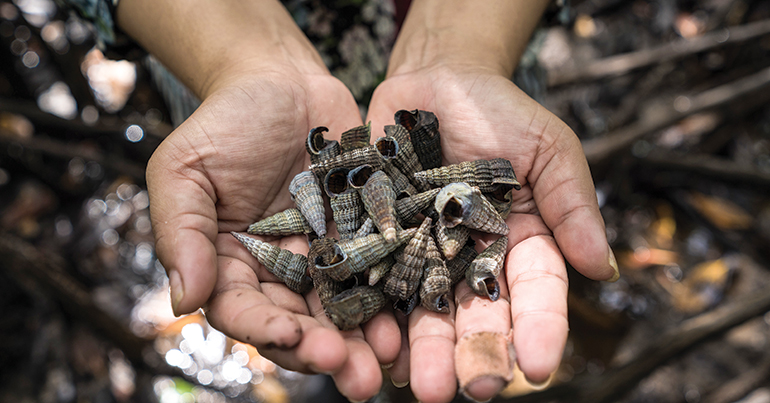
Soth Sophea, 34, collects shells from the mangrove forest. Photo: Thomas Cristofoletti
Her husband, Mom Nari, 54, says on days that he brings in fish, he makes about $7.50 after paying costs such as gasoline. But he has only been able to go out three times in as many weeks, with monsoon season making the far waters where fish still swim too dangerous to navigate, and that income falls drastically short of the $30 a day he used to make when the waters were teeming with life.
The two families’ situation is not uncommon in Koh Sralao, according to Asif of the University of Ottawa. While researching the small village’s migration trends in 2016 and 2017, he found that 61% of households he surveyed had sent at least one family member away to find work in recent years.
According to Saron, the former village chief, entire families have vanished from Koh Sralao without a word or a way to contact them as they attempt to flee their suffocating debt. Back in the mangrove forests surrounding Koh Sralao, his daughter works tirelessly to ensure their fate won’t be the same. Instead, Teav’s future will be one of determined survival. She nimbly slithers above the raised roots of the mangrove trees, and at times her feet sink into the wet mud below. If she can’t bring home fish and crabs, she’ll try to bring in profit with each long butt snail she can spot.
She slips her hands in her pockets and then holds them out in front of her. They’re stacked with the gray cone-shaped shells. “My pockets are almost full.”
Sand, Cement & Brick: This is the first in our three-part series on the true costs of Cambodia’s building blocks. Follow these links to read parts two and three.


